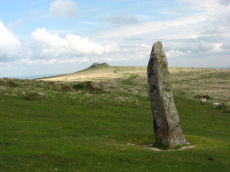Did Torquay have its own version of Stonehenge? Unlikely as this may seem, stone monuments were once common in southern Britain. Most of these have now gone, they’ve been dismantled and ploughed under over the past few thousand years. Those that remain tend to be in places less exploited by man – Dartmoor, for example. So if we did have stone rows, circles and megaliths, where might they have been? One possible location is at Gallows Gate by the roundabout at the top of Hamelin Way on the A380.

Here’s the reasons why. First of all Gallows Gate (pictured above) has had a range of uses which in other places are associated with ancient monuments. At around 495 feet above sea level, the site is on an ancient ridge way and where the four parishes of Cockington, Marldon, Kingskerswell and St Marychurch meet. Borders were important as they decided where people paid taxes and who was owed loyalty in a feudal society. Usually a boundary needed to be easily identified so a prominent mark in the landscape would have been useful.
Here was the site for public executions for those communities which now make up Torquay. By the side of one of the Bay’s busiest roads, many hundreds of people have lost their lives at the end of a rope. In 1436 the Cockington Manor Court referred to a ‘stope’, usually defined as a gibbet or whipping post which could be at Gallows Gate. A Marldon Tithe Map of 1839 also shows a three-cornered field called Gallows Gate Field.

Gallows and gibbets were often set up in places which had long-standing significance for local communities. To the south is Dada Croft – the similar sounding ‘daudaz’ is Saxon for ‘dead’, so it’s reasonable to see the small enclosed field as a place reserved for the remains of those who had been executed. It’s generally thought, however, that the original site of the gallows was 170 meters to the north, at Kingsland, the highest point and where the reservoir now is. One suggestion is that the gallows were moved in the 1820s when public opinion began to turn against disorderly public hangings and the suspended rotting corpses which could be seen for miles around.
The Haytor Hundred is recorded as being held at Kingsland (the King’s Land). This would have seen gatherings of men called to fight and hold open air courts, as well as providing a good lookout for sighting hostile ships in the Bay. The partition of Devon into Hundreds dates from King Alfred (871-901) and so this could mean that Gallows Gate served for over a thousand years as a place of execution.
Indeed, our place for terminal justice could have a much longer history, going back to the age of monument building – the Neolithic or New Stone Age (4500BC and 2200BC) and the Bronze Age (2200BC to 700BC).
Perhaps significantly, in an inventory of 1654, the area was known as Stauntor, Stontor or Stantor, meaning ‘stone hill or eminence’. This could indicate that the original site had a monolith or “some such monument to a prehistoric chieftain”. We know the Anglo-Saxons used old burial mounds and Bronze Age sites as places for the execution of criminals when they were removed from villages. These locations then became associated with ghosts and demons.

Another piece of evidence is the ‘sheep hangs man’ legend. There’s an old gate along with a plaque which tells the legend of a man who stole a sheep which he tried to carry away slung by a rope on his back (pictured above). In getting over a high gate, the carcass fell on side and the thief the other – the stolen sheep hanged the thief. The Victorian-era gate remains to commemorate the legend.

Variants of the same story, however, can be found in other places. In Devon alone there are nine, with five of these found on Dartmoor – there being a cluster around Tavistock. The difference is that, instead of a gate, the rope is caught around a rock – hence the ‘hanging stones’ across the Moor. The story seems to indicate the importance of sheep farming. In 1741 a law specifically defined the death penalty for sheep stealing – by 1825 out of a total of 9,316 death sentences passed in Britain, 1,039 were for that offence. Across Britain hanging stones are to be found on parish boundaries and are often associated with nearby gallows. Was there originally a standing stone at Gallows Gate?

There was certainly some human activity going on. In July 1964, and again in early 1965, deep chasms appeared near the summit of Kingsland Hill. The Water Board investigated and found two passages 12 meters below the surface and several hundred meters long. Fragments of bone and wood were found, indicating that at one time the pits were open. Presumably, Bronze Age people weren’t living at the top of an exposed hill, so what were they doing there? There’s also a Neolithic chambered tomb not too far away at Broadsands – soil within has been dated to 3768-3641 BC (pictured below).

Therefore, there may have been standing stones or some kind of monument at Gallows Gate. It wouldn’t, of course, have been as large or significant as Stonehenge – think of the giant Wiltshire monument as the equivalent of a cathedral with smaller stone circles, such as that possibly at Gallows Gate, being like parish churches.

So, Gallows Gate has been important to local people for many reasons over thousands of years. We’ll never know for sure what the origins of Gallows Gate were, but we can reasonably suggest that this largely unnoticed plot of land has seen rituals of life and death since prehistoric times.



























